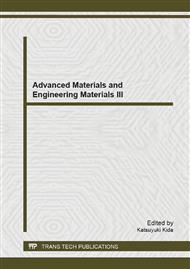p.119
p.124
p.128
p.132
p.136
p.141
p.145
p.149
p.153
Effect of NaOH Concentration and the Addition of NiCl2 on the Preparation of Ni/NiO/C Composite Nanofibers
Abstract:
Ni/NiO/C composite nanofiber with 60 nm in diameter was prepared by electrospinning and subsequent carbonization. The composition and morphology were characterized by X-ray diffraction and scanning electron microscopy. The electrochemical properties were preliminarily evaluated. It is found that both NaOH concentration and the addition of NiCl2 are key factors for the morphology of composite nanofibers. An electrochemical study reveals that the obtained Ni/NiO/C composite nanofiber exhibits excellent rate capability which makes it promising anode material for Li ion batteries. In addition, our simple and inexpensive stragegy can be further extended to create various functional hybrid nanomaterials.
Info:
Periodical:
Pages:
136-140
Citation:
Online since:
February 2014
Authors:
Keywords:
Price:
Сopyright:
© 2014 Trans Tech Publications Ltd. All Rights Reserved
Share:
Citation:


